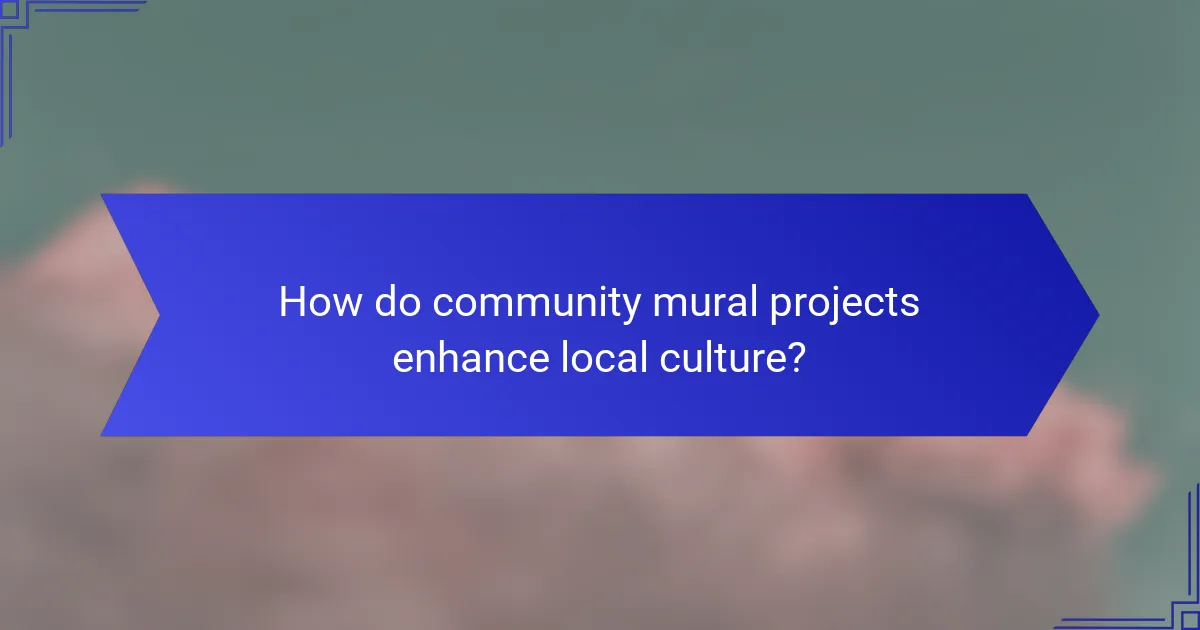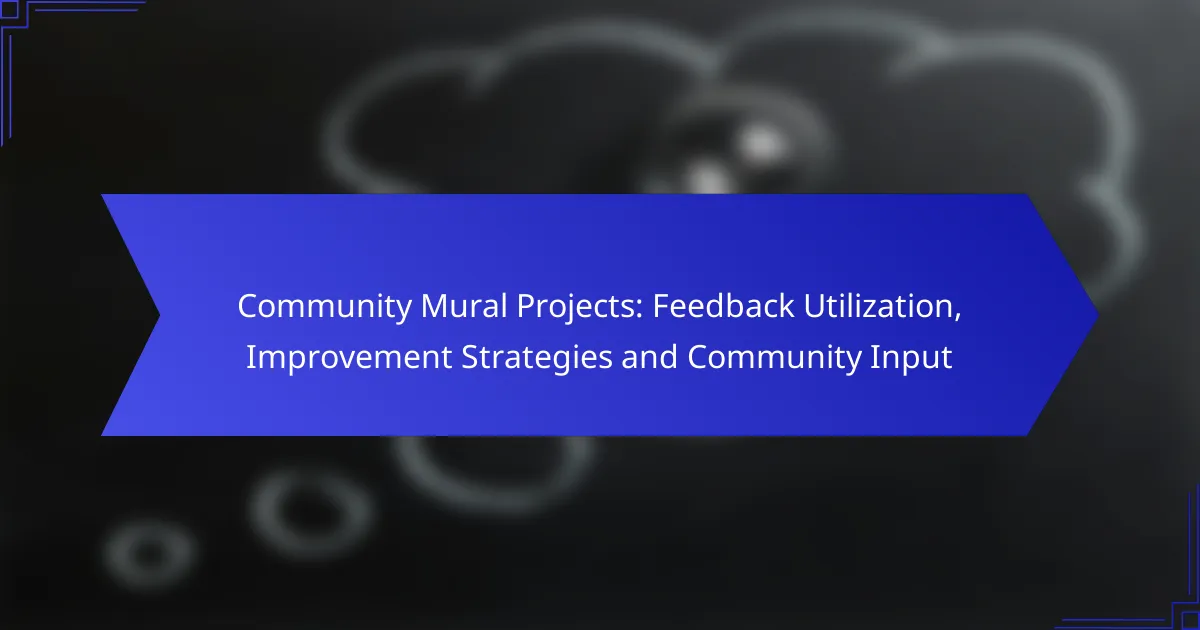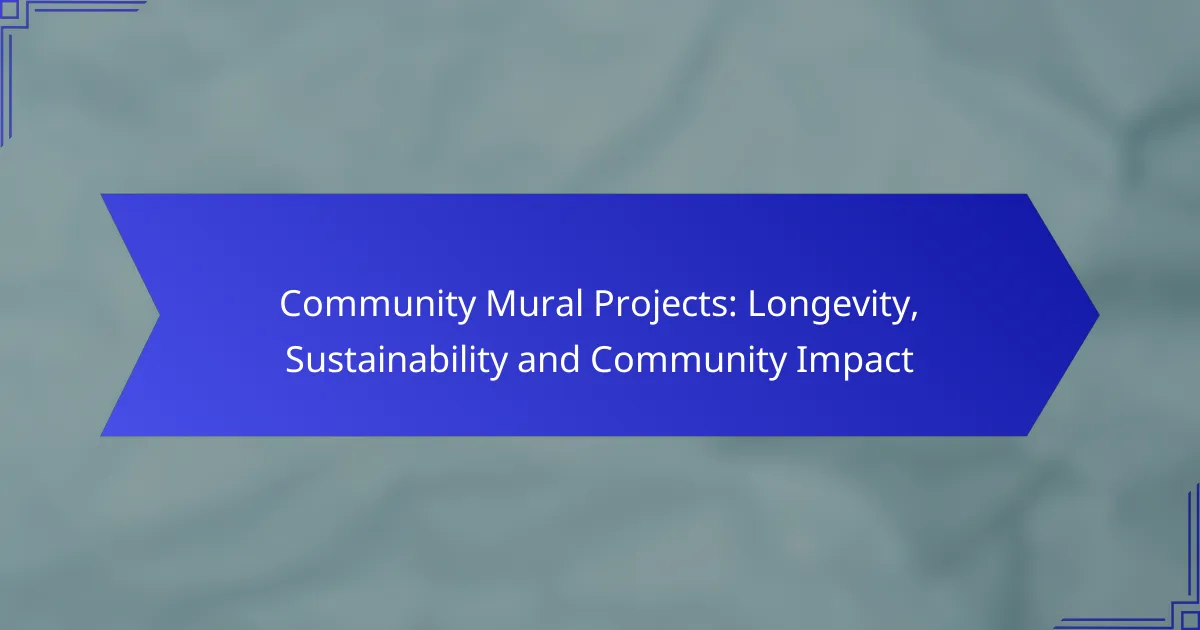Community mural projects serve as a powerful tool for enhancing local culture and fostering artistic expression. By transforming public spaces into vibrant displays of creativity, these initiatives promote community engagement and celebrate the unique identity and heritage of the area. Through collaboration and shared ownership, residents build stronger social connections and pride in their neighborhoods.

How do community mural projects enhance local culture?
Community mural projects enhance local culture by fostering artistic expression, promoting community engagement, and celebrating cultural heritage. These initiatives transform public spaces into vibrant canvases that reflect the unique identity and values of the community.
Promotion of local artists
Community mural projects provide a platform for local artists to showcase their talents and creativity. By involving artists from the area, these projects not only elevate their profiles but also encourage the development of a local art scene. This can lead to increased opportunities for artists, such as commissions and exhibitions.
Additionally, local artists often draw inspiration from their surroundings, creating murals that resonate with the community’s experiences and stories. This connection can foster pride and ownership among residents.
Reflection of community identity
Murals often serve as visual narratives that reflect the history, values, and aspirations of a community. They can depict significant events, cultural symbols, or local legends, allowing residents to connect with their heritage. This representation can strengthen community bonds and foster a sense of belonging.
Moreover, murals can be designed collaboratively, involving community members in the creative process. This engagement ensures that the final artwork truly represents the collective identity and voice of the community.
Attraction of tourism
Well-executed community murals can become iconic landmarks that attract tourists and art enthusiasts. Unique and visually striking murals often encourage visitors to explore the area, boosting local businesses and the economy. This influx of tourism can lead to increased funding for future community projects.
To maximize the impact, communities can promote their murals through social media, local events, and guided tours. Highlighting the stories behind the murals can enhance visitor engagement and appreciation, making the area a must-visit destination.

What are the benefits of community engagement in mural projects?
Community engagement in mural projects offers numerous benefits, including enhanced social connections and a shared sense of ownership among residents. These projects not only beautify neighborhoods but also foster collaboration and pride within the community.
Strengthening community bonds
Community mural projects create opportunities for residents to come together, share ideas, and work towards a common goal. This collaboration often leads to stronger relationships among neighbors, as individuals from diverse backgrounds unite to contribute their skills and perspectives.
For example, a local mural project might involve workshops where community members can brainstorm designs and paint together, reinforcing connections and trust. As participants engage in the creative process, they develop a sense of belonging and commitment to their neighborhood.
Encouraging collaboration
Mural projects encourage collaboration by bringing together artists, local organizations, and residents. This teamwork can lead to innovative ideas and solutions, as different stakeholders contribute their expertise and resources.
In practice, a successful mural project might involve partnerships with schools, businesses, and cultural institutions, allowing for a diverse range of input. This collaborative spirit not only enriches the mural’s design but also strengthens community networks.
Fostering civic pride
Community murals can significantly enhance civic pride by showcasing local culture, history, and values. When residents see their stories and heritage represented in public art, it fosters a sense of ownership and pride in their community.
For instance, a mural depicting local landmarks or historical figures can serve as a reminder of the community’s unique identity. This pride often translates into increased civic engagement, as residents become more invested in local initiatives and improvements.

How can businesses support community mural projects?
Businesses can play a crucial role in supporting community mural projects by providing financial backing, resources, and collaborative opportunities. Engaging with local artists and community members not only enhances the project but also strengthens the business’s connection to the community.
Sponsorship opportunities
Businesses can sponsor community mural projects by providing funding that covers artist fees, permits, and other associated costs. Sponsorship can range from a few hundred to several thousand dollars, depending on the project’s scale and complexity. In return, businesses often receive recognition through promotional materials and signage at the mural site.
When considering sponsorship, businesses should evaluate the potential visibility and community impact of the mural. Aligning the mural’s theme with the business’s values can enhance brand reputation and foster goodwill among local residents.
Collaborative marketing initiatives
Collaborative marketing initiatives can amplify the reach of community mural projects. Businesses can partner with local artists to create promotional campaigns that highlight the mural’s creation process and its significance to the community. This can include social media promotions, events, or even merchandise featuring the mural’s design.
Engaging in these initiatives not only promotes the mural but also drives traffic to the business. For example, hosting an unveiling event can attract customers and create a festive atmosphere, benefiting both the mural and the business.
Providing materials and resources
Businesses can support community mural projects by donating materials such as paint, brushes, and scaffolding. Providing these resources can significantly reduce project costs and encourage more artists to participate. Establishing partnerships with local suppliers can also ensure that high-quality materials are used, enhancing the mural’s longevity.
Additionally, businesses can offer logistical support, such as access to their facilities for planning meetings or workshops. This type of involvement fosters a collaborative environment and strengthens community ties, making the mural project a shared success.

What are the steps to organize a community mural project?
Organizing a community mural project involves several key steps that ensure community involvement and artistic expression. The process typically includes gathering input from the community, selecting an appropriate location, and choosing artists and designs that reflect the community’s values and culture.
Gathering community input
Engaging the community is crucial for the success of a mural project. Start by hosting meetings or workshops where residents can share their ideas and preferences regarding themes, colors, and messages. Surveys can also be distributed to gather broader input.
Consider forming a committee that includes diverse community members to represent various perspectives. This involvement fosters a sense of ownership and pride in the project, making it more likely to resonate with the local population.
Selecting a mural location
Choosing the right location for the mural is essential for visibility and impact. Look for high-traffic areas where the mural can be easily seen, such as community centers, parks, or busy streets. Ensure that the site has the necessary permissions from property owners and local authorities.
Evaluate the physical condition of the wall and surrounding environment. A clean, well-maintained wall will enhance the mural’s appearance and longevity. Additionally, consider how the location interacts with the community; it should be a space that invites engagement and appreciation.
Choosing artists and designs
Selecting artists who align with the community’s vision is vital. You can invite local artists to submit proposals or hold an open call for submissions. Review their portfolios to ensure their style matches the intended theme and aesthetic of the mural.
Once artists are chosen, collaborate with them to finalize the design. This process should involve community feedback to ensure the mural reflects local culture and values. Consider creating a mock-up or digital rendering to visualize the final product before painting begins.

What criteria should be considered for mural design?
When designing a mural, it’s essential to consider factors such as community relevance, material durability, and inclusivity of diverse voices. These criteria ensure that the mural resonates with the local population, stands the test of time, and represents a broad spectrum of community perspectives.
Relevance to community themes
The mural should reflect the unique themes and values of the community it represents. Engaging with local residents through surveys or workshops can help identify significant cultural symbols, historical events, or social issues that the mural can address.
For example, a mural in a neighborhood known for its rich immigrant history might incorporate elements from various cultures, celebrating diversity and unity. This relevance fosters a sense of ownership and pride among community members.
Durability of materials
Selecting durable materials is crucial for ensuring the mural withstands environmental factors and maintains its appearance over time. Common choices include weather-resistant paints, sealants, and substrates that can endure elements like sun, rain, and temperature fluctuations.
For instance, using high-quality exterior acrylic paints can enhance longevity, while protective coatings can prevent fading and damage. It’s advisable to consider local climate conditions when choosing materials to ensure the mural remains vibrant and intact for years.
Inclusivity of diverse voices
Incorporating diverse voices in the mural design process enriches the artwork and fosters community cohesion. This can be achieved by inviting artists from various backgrounds or hosting community meetings to gather input from different demographic groups.
By ensuring representation, the mural can serve as a platform for storytelling and cultural expression. This inclusivity not only enhances the mural’s impact but also encourages community members to engage with and take pride in the finished work.

How do mural projects impact local economies?
Mural projects can significantly enhance local economies by creating jobs, increasing business revenue, and boosting property values. These initiatives not only beautify neighborhoods but also attract visitors and foster community pride, leading to economic growth.
Job creation for local artists
Mural projects often provide employment opportunities for local artists, allowing them to showcase their talents while earning a living. This can include mural design, painting, and project management roles, which can lead to a vibrant local arts scene.
Additionally, these projects may involve collaboration with other professionals, such as graphic designers and community organizers, further expanding job opportunities within the creative sector.
Increase in local business revenue
When murals are installed in a community, they can draw increased foot traffic, benefiting local businesses. Shops and restaurants near murals often see a rise in customers who come to view the artwork, leading to higher sales and revenue.
Moreover, businesses can leverage the popularity of murals for marketing purposes, creating special promotions or events that capitalize on the increased visibility and interest generated by the artwork.
Boosting property values
Murals can enhance the aesthetic appeal of neighborhoods, which may lead to an increase in property values. Homebuyers often seek out visually appealing areas, and vibrant murals can make a neighborhood more attractive.
Research indicates that properties near well-maintained public art installations can see value increases ranging from low single digits to double digits, depending on the overall market conditions and community engagement.










